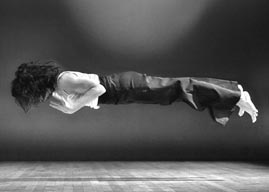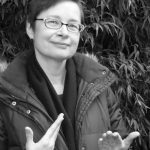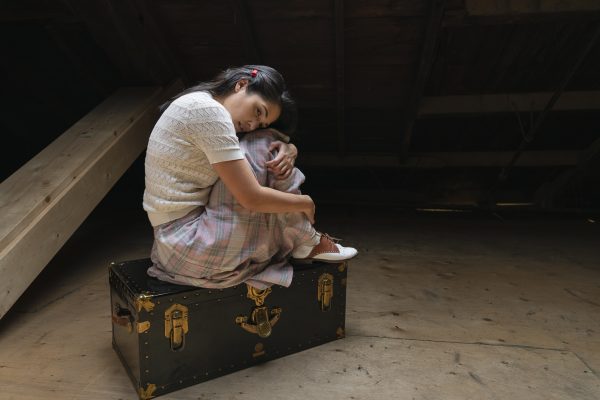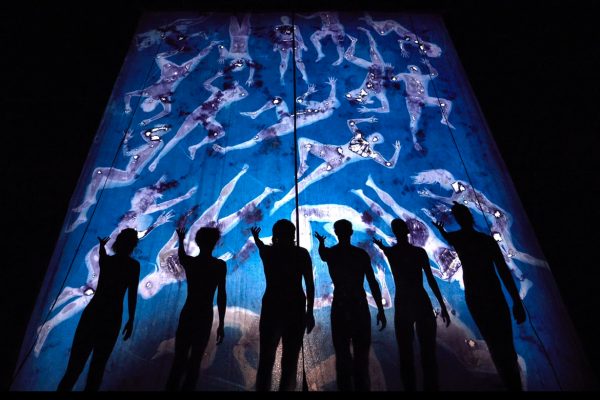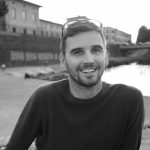I am From Reykyavik played at Parc La Fontaine, Parc Morgan and the front court of the Piscine Saint-Denis on June 1-4 as part of Festival TransAmériques in Montreal. It will be presented at R.V. Burgess Park, Withrow Park, Sugar Beach and Yonge-Dundas Square in Toronto as part of Luminato Festival from June 7 to12.
The choreographic premise is simple enough: find a spot in a neighbourhood, build a tiny house over seven hours and take it down. I Am From Reykjavik, by Sonia Hughes, a British artist, writer, director and performer, is a quietly stunning evocation about place, space, migration, the meanings of home, race, identity, access and belonging. Though she’s previously collaborated with contemporary theatremakers, choreographers and performance artists, her website indicates this show is Hughes’ “first major foray into making solo work in the public realm.”
I arrive early at Parc Morgan, in the Hochelaga-Maisonneuve district, and see a single small, discreet poster announcing the performance. Seems odd, but also indicative, I feel, of the desire to keep this a low-key event. I also see a number of pitched tents in one corner of the park, complete with hibachis. Could this be the site? I feel like I’m intruding into someone’s home.
I retreat and walk towards the park chalet, where I see a couple of women clearing the area and covering belongings with a tarp. Another woman is changing clothes. Again, I feel I’ve breached a private space.
I wander further. It’s a lovely sunny day, a comfortable 25 degrees, but it progresses to be a scorcher. Montreal has exploded in spring green.
When I come across Hughes, a Black woman in her 60s, I clue in that it’s her because someone is taking photos as she walks on the grass. Turns out, it’s her son, photographer Solomon Hughes, documenting the day.
Nothing unusual is happening, no hint of a performance, other than this woman demarcating her space with a tape measure. She sets a little pop-up garden and a bright plastic bag (from an Icelandic department store) in each corner. She then squares off a yellow line on the grass with a spray can. Afterwards, she sits on a small box-like wooden seat, claiming her space. An architect, Lee Ivett, has designed the tiny home, but there is no lighting design for this work.
After a few minutes, Hughes stands and ambles out of the bounded space. She continues onto the sidewalk, and finally out of view. Eventually, she returns, pulling a trolley stacked with building materials. She will do this several times during the first part of the performance.

At this point, the piece feels like a slow burn. As Hughes goes about her business, I have a multitude of questions, but I choose to observe rather than engage. There are only a handful of people present, which affects the way I’m experiencing the piece. I think about this in light of the fact that some 600 people had gathered for the previous day’s show in the vast, centrally located Parc La Fontaine.
In this piece, there’s something more subtle and quotidian unfolding. The essence of the work is not so much the building of the house, although it is the obvious activity. It’s about the interactions that develop with passersby, not spectators.
Two women who have been watching nearby approach Hughes and begin asking questions. I see that one is translating. It turns out she’s from the festival, onsite expressly for this purpose. I cannot hear the conversation as I’m too far away, but Hughes seems unperturbed and happy to chat. There’s a lot of animated gesturing on the part of one woman. And laughter. Neither woman helps Hughes as she continues to build her mini-house.
The title of this work underscores the precarious nature of the simple but loaded question, “Where are you from?” or the subsequent offensive query, “No, where are you really from?” which is a way of saying you don’t belong here. Having read that Hughes is living in Marsden, a village in West Yorkshire, England, I eventually ask her, “Why Reykjavik?” She says there’s no particular reason, simply that the idea for the performance sprang up in the Icelandic city when she was visiting with friends.
I think of Reykjavik as a place of passage, an entry point to Europe and beyond, which, in my mind, fits the themes of the work. Hughes asks me directly where I am from. Soon we’re discussing our migratory histories and why family sometimes grounds us in a place. This exchange is warm and personal. She talks about the garden that her father cherished, the fruit trees on his property and how he wanted her to maintain those trees after he was gone. After he died, she sold the house. She says she didn’t feel regret at losing those trees. I suggest those memories are inside her, and she smiles affectionately.
Up until this point, Hughes has been wearing a loose brown dress. Now, she slips a dark green caftan over her head and stands in place on the wooden foundation she’s built. It’s striking seeing her rooted, calm, seemingly asserting her space. Her gaze is internal; there is no affect or gesture, just a clarity, for herself certainly, but one that extends to anyone who cares to witness.
I circulate in the park, checking out perspectives of the installation from different angles. The sun has shifted, and the tree cover she’s benefitted from over these first two and a half hours has vanished. I think that will be brutal as the day proceeds. When I decide to leave, I see Hughes lying on the platform, in repose, creating an imprint, transforming the space into an expression of her present and past.
This is the best work I’ve seen in the festival this year – her inquiry is deeply moving as it activates the essence of empowerment and resilience without didacticism. Fundamentally, it’s a look at humanity and the stamp of one woman moving in the world.
Tagged:


